On the beach of a remote Kiribati atoll 60 years ago, Paul Ah Poy and hundreds of others were ordered to turn around, crouch and cover their eyes.
Huddled together on the beach with hands on eyes and collars popped, Mr Ah Poy listened as a voice bellowed from loudspeakers, counting down from ten.
Then, on zero, came a wave of searing heat and a flash that was indescribably bright. "We had the palm of our hands over our eyes, I closed my eyes but I could still see the skeleton of my fingers through my closed eyes."
"I was squirming because I thought my shirt was going to burst into flames," Mr Ah Poy said in an interview.
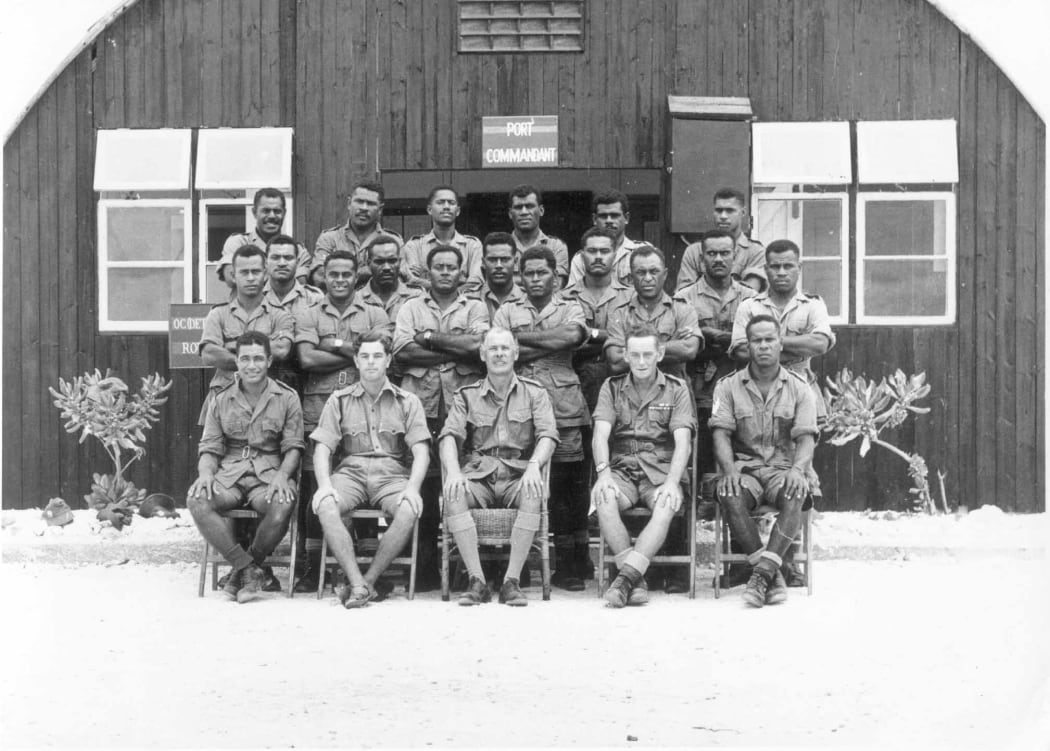
Fijian troops on Christmas Island during Operation Grapple. Photo: Photo courtesy Mrs Loata Masi
On that day, 28 April 1958, a Royal Air Force plane dropped Britain's largest ever hydrogen bomb off the shore of Kiritimati, then called Christmas Island, in the colony of Gilbert and Ellice Islands.
The bomb - called Grapple-Y - exploded thousands of feet in the air, with a yield of 3 megatonnes, roughly equivalent to about 3 million tonnes of TNT.
At first, everything was silent. Then the shockwaves came.
"BOOM BOOM BOOM BOOM," Mr Ah Poy dramatically recalled, "the sand and stones flew in the air and came down again. And then they told us, 'now you can stand up slowly.'
"We stood up and we could see what had happened. We saw this big ball in the sky. You could not see the sun anymore."
The test of 60 years ago was the largest of Britain's nine nuclear tests at Christmas and nearby Malden Island in 1957 and 1958, which involved the support of military personnel from both New Zealand and Fiji.
Some 14,000 people were deployed to Christmas Island, working as scientists or labourers. Many say they were exposed to high amounts of radiation, and given little or no protective gear when the bombs went off.
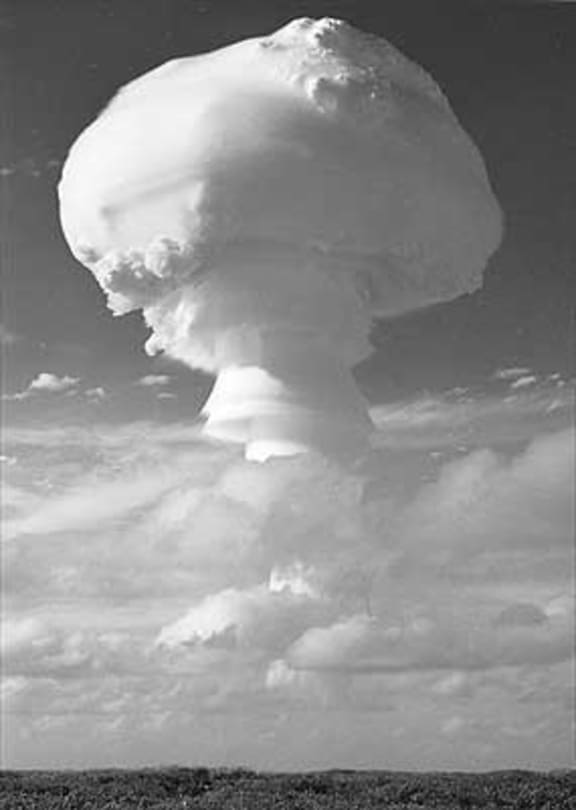
The mushroom cloud from the British Grapple-Y nuclear test on Christmas Island, April 28 1958. Photo: Supplied
On their return, many developed cancers, found they were sterile, or had children with congenital deformities and other illnesses.
But to this day, Britain insists its nuclear tests were clean and caused no ill effect, maintaining that there is no conclusive link between the tests and the high rates of cancer among veterans.
The government has refused to pay any form of compensation. Instead, the Department of Defence has spent millions blocking legal claims brought by veterans that have gone as far as the Supreme Court in London.
That continues to rankle veterans like Mr Ah Poy, who as a 20 year old boarded a ship bound for Christmas Island to give his part to the Cold War project of a distant ruler.
On the 60th anniversary of the Grapple-Y test, as their health deteriorates and their numbers wither, Mr Ah Poy and many other veterans- in Fiji, Kiribati, New Zealand and the United Kingdom - are still fighting for recognition and compensation as they deal with persistent health problems.
The anniversary also comes at a time when Britain, in search of friends as it leaves the European Union, plans a return to the Pacific. Just two weeks ago, Foreign Secretary Boris Johnson spoke of his intention to ramp up its presence, increase engagement and show itself as a friend to the Pacific.
"What I would like to see is for the British to own up," said Mr Ah Poy. "Time's not on our side."
Looking to foot it
The United Kingdom's drive for a hydrogen bomb was, in many respects, a mighty push for relevance amid the final gasps of empire.
The Cold War was raging, and a diminished Britain was trying to maintain its status as a global power.
In advocating for a hydrogen bomb, Prime Minister Sir Winston Churchill's scientific advisor Lord Cherwell said: "If we are unable to make the bomb ourselves and have to rely entirely on the United States for this vital weapon, we shall sink to the rank of a second-class nation."
But in 1955, resistance was building to nuclear weapons, especially the hydrogen bomb.
Protests were spreading, especially in the wake of the massive tests carried out by the United States in the Marshall Islands, and talk of a test ban was growing.
In the Pacific, there were protests in Western Samoa, Cook Islands, Fiji, all of which were still British or New Zealand colonies, but well down a path to independence.
Britain's early nuclear tests were carried out in the Australian outback, but when the prospect of a hydrogen bomb was raised, the Australian government of Prime Minister Robert Menzies grew reluctant in the face of growing opposition.
Denied access to Australia, the British government approached New Zealand about using the northern Kermadec Islands as a testing area. Prime Minister Sidney Holland rejected that approach, reportedly saying it would be a 'political H-bomb.'
5,000km to the north, though, Britain had a colony where it didn't have to ask: Christmas Island.
"The local people had no say about this," said Nic Maclellan, a researcher who last year published the book "Grappling with the Bomb: Britain's Pacific H-bomb Tests."
"There was a copra plantation on [Christmas] island, and that plantation was basically put on hold and a lot of the plantation workers were then hired by the British military as labourers," he said.
"From 1956 onwards, the British built a massive military base, a big airstrip, and some 14,000 British troops were deployed to the Pacific for this operation."
Among those 14,000 troops were 550 New Zealand sailors on two frigates, and 276 soldiers from Fiji. One of them was 20-year-old Paul Ah Poy.
"We were told that we were going to do sea training," he said. "And we were eager because we were young. We were glad to go out."
But he said none of the Fijian contingent were told what they were going to be a part of. "We went to Christmas Island and when we got there, we found out - they told us - that they were going to test their nuclear weapons."
"We didn't even know what a nuclear weapon was. There was no word for nuclear in the Fijian language, there's no word for radiation. We didn't know what it was until we were told to follow orders and they tested their nuclear weapons," he said.
Mr Maclellan said his research also showed that many of the men were not told what exactly it was they would encounter.
For five days a week over several months, Mr Ah Poy and the Fiji contingent sailed a landing craft back and forth from the atoll's shore to large cargo ships. In the sweltering Kiribati heat they would load and unload the ships, readying the massive test site.
On testing days - there were seven in total for Mr Ah Poy, including Grapple-Y - they were herded onto the beach, where they were told to crouch and cover their eyes, facing away from the drop site.
"Where did the officers disappear to on that day?" he asked. "And the scientists? They were in the bunkers while the ordinary sailors, soldiers and airmen were lined up on the beach listening to the loudspeakers. They were told to listen and follow orders, which we did."
The British authorities insist their operation was well planned, and every measure was taken to ensure the safety of both personnel and the Christmas Island locals, many of whom were relocated onto navy ships when the tests were conducted.
Every member was kept at a safe distance, at least 10 miles from the drop zone, they say, and given film badges to monitor the levels of radiation they were exposed to.
However, many of those badges were not processed, owing to problems with storing the chemicals to process them. And, Mr Maclellan said, many of the precautions written up in London were never carried out on Christmas Island.
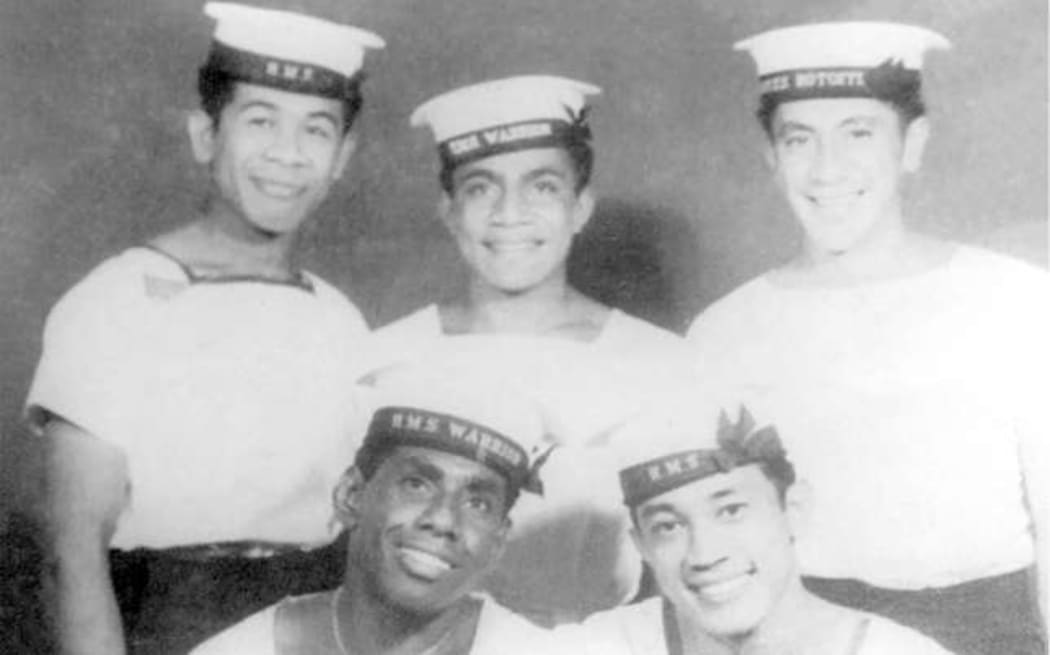
Paul Ah Poy, left, was sent to Christmas Island as a young sailor. Photo: Paul Ah Poy
"Corners were cut," he said, adding that the international momentum against thermonuclear weapons pushed British authorities to speed up the tests - including moving the tests from faraway Malden Island to the southeast tip of Christmas Island, close to both personnel and i-Kiribati families.
"There's a lot of evidence that's found in the archives to show that the British cut corners on safety, creating a danger zone that removed inhabited islands from the supposed danger zone," said Mr Maclellan.
"So they knew that there were hazards for the small Micronesian populations on neighbouring atolls and they went ahead with the tests regardless."
Mr Ah Poy said he didn't even get a film badge. "They seemed to pick only a certain group of people to wear protective gear. I wasn't given any protective gear," he recalled.
"No film to record the dose of radiation. Nothing at all. It looks like we were guinea pigs."
'I thought I was just ageing'
Mr Ah Poy returned to Fiji in mid-1958 and, like everyone else, he looked to live a normal life and start a family. Little did he know he would be at the front of a battle that would last longer than half-a-century.
A few months after his return, he started to notice that his hair was falling out and his gums would bleed regularly.
"I thought it was normal," he said. "I thought I was just ageing. You do lose your hair."
But several other veterans he knew were experiencing the same. Some developed cancers at a young age. Others struggled to have children, including Mr Ah Poy.
"I had two children, a boy and girl," he said, his voice starting to quiver.
"My daughter came out but she was not quite normal. She was a beautiful girl. My boy is normal, but today he cannot have children. But the girl, she died when she was three and a half years."
There may have been a suspicion, but Mr Ah Poy said no one seriously linked their health issues to their experience at the nuclear test sites for several decades. Why would they, he asked, when the British military said there was no evidence that the radiation they would have experienced could cause any problems.
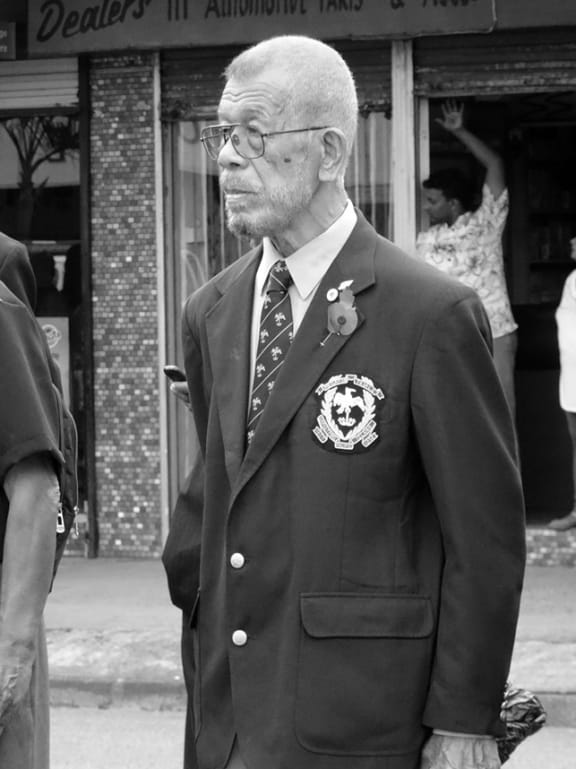
Paul Ah Poy at a commemoration ceremony in Suva in 2015. He is now the president of the Fiji Nuclear Veterans Association. Photo: ANU Press
In the 1980s, though, the United States conceded that its nuclear testing had contributed to negative health effects for those who were there, and set aside a compensation scheme for those affected by tests on the Marshall Islands.
In 1999, Mr Ah Poy said, a Fiji school teacher went on an exchange to the Marshall Islands and found similar ailments there to those that Mr Ah Poy and his fellow veterans were experiencing.
The teacher placed an advertisement in local newspapers and on radio, and the veterans gathered.
Their stories were all the same: many could not have children, and if they did they had health issues or genetic abnormalities; several had contracted leukaemia or other cancers; many veterans could not make it, they were already dead.
Mr Ah Poy said they got in touch with similar veterans' organisations in New Zealand and Britain: the same experience was being shared there, too.
And so the fight began.
The veterans' organisations took the Ministry of Defence through the British courts. Their claim was supported by the High Court, but the Ministry of Defence appealed against that.
The Court of Appeal and Supreme Court ultimately rejected their claims for damages, saying there was little evidence to show that the tests were the sole cause of the men's illnesses, nor that the Ministry of Defence was negligent.
Successive British governments continue to maintain there was no danger from radioactive fallout, often citing government-commissioned research.
However, Mr Maclellan said a range of independent research continues to show that there are effects, and that those who were at or near nuclear test sites experience cancer at twice the rate of the rest of the population.
A 2007 study from New Zealand's Massey University also found that the veterans of Christmas Island had suffered genetic damage as a result of radiation.
Far from over
A portrait of Queen Elizabeth still hangs on the wall of Paul Ah Poy's Suva home. 80-years-old and increasingly frail, Mr Ah Poy said he relies on government pensions and the support of his family.
"We went there for our Queen," he said. "We'd like the British government to do what is right."
Mr Ah Poy said his organisation - there are only 35 Fiji veterans left of the 276 who went to Christmas Island - will not be giving up their fight for recognition.
And increasingly, Britain's insistence that its nuclear tests were clean is a lonely stand.
Like Britain, until 2009 the French government also denied any suggestion that its tests were harmful to health and the environment, until it finally introduced a programme to give compensation to victims of radiation exposure.
But of more than 1,000 claims, only 19 people received compensation.
Last year, though, the overseas minister, Annick Girardin, admitted France had been slow in recognising its nuclear aftermath, and announced plans to revisit all rejected claims, as well as increasing health support and monitoring for veterans.
The United States has operated a compensation scheme since the early 1990s. However, that money is drying up, and the Marshall Islands communities who were relocated by the United States from Bikini Island continue to live in squalor.
Mr Maclellan said as deficient as the French and US compensation schemes may be, at least there's something.
"This is the great tragedy," he said. "Other nuclear powers that tested in the Pacific have acknowledged - belatedly - that there were health effects and have set up systems for compensation both for health and environmental damage."
"The British refuse to acknowledge their responsibility and this continues to this day."
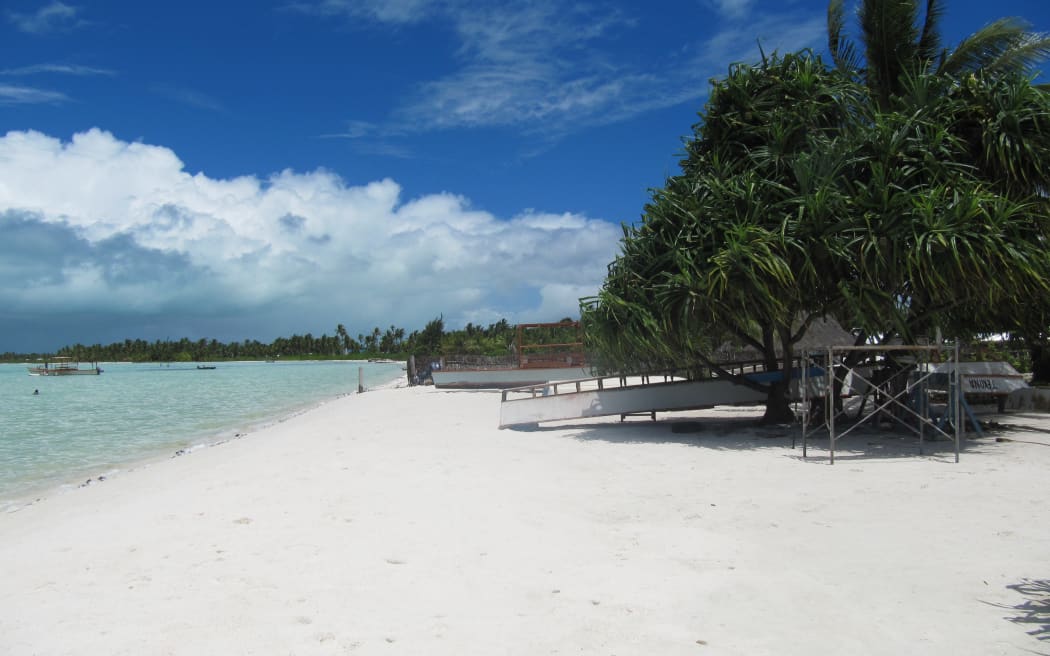
Kiritimati Island as it is today. Photo: RNZ
Mr Maclellan said with legal avenues exhausted, the remaining veterans and their families - including those in New Zealand and Fiji - were looking for some political leadership.
In 2015, Fiji Prime Minister Frank Bainimarama, whose father was a Christmas Island veteran, announced a small compensation scheme, saying: "Fiji is not prepared to wait for Britain to do the right thing. We owe it to these men to help them now, not wait for the British politicians and bureaucrats."
However, Mr Ah Poy said the payments were small, and still, it was not Fiji's responsibility. The country was not independent until 1970 - Britain was the colonial ruler who sent them to Christmas Island.
As he detailed his fight in a lengthy interview, Mr Ah Poy couldn't help but be cynical.
"Time is not on our side," he said. "They are stalling, it is the plot of politicians."
"What I would like to see is for the British to own up, to say that they were at fault."
Mr Maclellan said after April's Commonwealth Heads of Government meeting, with the British government trying to show its benevolence to the Pacific, cleaning up its nuclear past could be a start.


